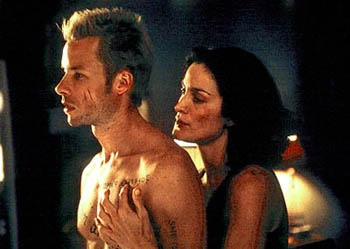![[Metroactive Movies]](/movies/gifs/movies468.gif)
[ Movies Index | Show Times | San Jose | Metroactive Central | Archives ]
 Community Chest: Guy Pearce bares his words to Carrie-Anne Moss. Backward Runs Mystery A man with no memory hunts his past for a killer in the puzzling 'Memento' NOVELIST Vladimir Nabokov described the use of kidnapping to manipulate a man as "the lever of love." Shouldn't the use of rape and revenge to manipulate an audience be called "the lever of lazy screenwriters?" Memento has a highly clever, if gimmicky, structure. The hero, Leonard Shelby (Guy Pearce), has, due to a trauma, lost his short-term memory. To him, reality consists of little loops that don't connect, leaving him stranded in an eternal present. Thus it makes narrative sense that Memento moves backward in time. The film starts with a murder and works into the past in little bites: we learn clues and motives just as Shelby forgets them. To prompt his faulty memory, Shelby keeps Polaroid photographs with captions. If a clue is especially significant, he has it tattooed on his skin. Across his breast, in mirror-writing letters, we see the most important memo to himself: "John G. raped and murdered your wife." In his search for the mysterious killer, Shelby is misled and manipulated by those around him. He's the perfect patsy, because he never remembers a trick. The problem is that the reliable lever-of-revenge fantasy won't work here. Shelby can't really remember the assault that killed his wife and stole his memory. The weight of experiences, the disappointment and the red herrings can't deepen a character who forgets everything. Pearce, who seemed so bottled up in L.A. Confidential, has a few dry humored, abstracted awakenings, coming to from his blackouts: What is it? Oh yes, now I remember. I'm running for my life. Pearce's inhuman physical perfection isn't marred by the inky graffiti all over his skin. But Pearce goes from implacable to wooden. A man who forgets everything but his mission of revenge is a kind of cyborg, useful only for pulp fiction unless the director can bring out depths in the story. Although Memento is beautifully photographed by Wally Pfister, director/co-writer Christopher Nolan doesn't find anything in the material to make it universal. There's not enough mordant humor to turn the story into an evil joke on Shelby and an entertainment for us. As a girl who hooks Shelby during his mission, Carrie-Anne Moss starts sinister and stays sinister. She never suggests those muted longings for a better life that give range to a bad-girl part. Stephen Tobolowsky and Harriet Harris co-star as two figures in a flashback, in a story Shelby remembers from before his wife's death. These two characters are so deep and sad that they pull the film off-balance--you become more interested in the backstory than the front story. Jorja Fox (who can't keep her mouth shut on TV's CSI.) has the dialogue-free part of Shelby's murdered wife. It seems like the wife ought to be the most important role. It seems also that this role was cast haphazardly, but maybe the problem is that Nolan didn't create a more poignant sense of lost marital love. When it goes Rashamonic and metaphysical at the disappointing end of the story, Memento gropes for a broader significance it doesn't earn. Sliced in a new direction, Memento is still the same old B-movie baloney. Only an audience of amnesiacs would find it completely groundbreaking.
Memento (R; 116 min.), directed by Christopher Nolan, written by Jonathan and Christopher Nolan, photographed by Wally Pfister and starring Guy Pearce, Carrie-Anne Moss and Stephen Tobolowsky, opens Friday at Camera One in San Jose and the Palo Alto Square in Palo Alto. [ San Jose | Metroactive Central | Archives ]
|
From the April 5-11, 2001 issue of Metro, Silicon Valley's Weekly Newspaper.
Copyright © 2001 Metro Publishing Inc. Metroactive is affiliated with the Boulevards Network.
For more information about the San Jose/Silicon Valley area, visit sanjose.com.